The Intel Broadwell Review Part 2: Overclocking, IPC and Generational Analysis
by Ian Cutress on August 3, 2015 8:00 AM ESTGenerational Tests: Office and Web Benchmarks
For this review, as mentioned on the front page, we retested some of the older CPUs under our new methodology. We did this testing at stock frequency as well as the IPC testing to see the ultimate real world result when you add in HyperThreading and frequency into the mix. If you recall back in our Devil’s Canyon i7-4790K review, the new high 4.4 GHz frequency of the i7-4790K was a tough one to beat for the newer architecture purely because any IPC gains are nullified by the older processor having a lot more frequency. With the Broadwell based i7-5775C being at 3.7 GHz and only 65W, this is a tough task. But what about if you are still running the Sandy Bridge based i7-2600K?
Some users will notice that in our benchmark database Bench, we keep data on the CPUs we’ve tested back over a decade and the benchmarks we were running back then. For a few of these benchmarks, such as Cinebench R10, we do actually run these on the new CPUs as well, although for the sake of brevity and relevance we tend not to put this data in the review. Well here are a few of those numbers too.
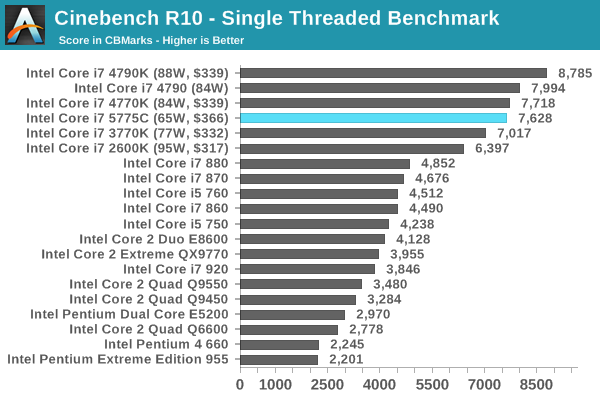
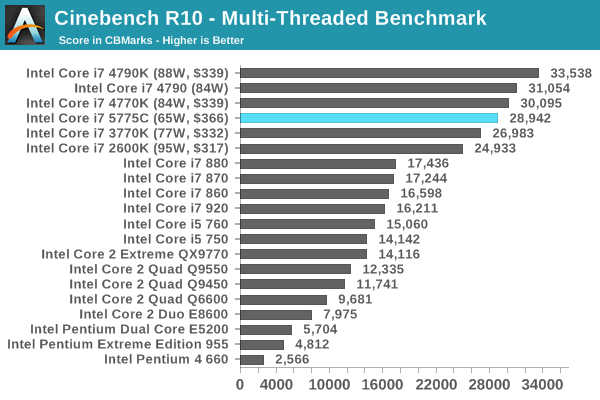


With some of these benchmarks, due to applications using new instruction sets, having the newer processors with the new instructions can make a lot of difference. Even in Cinebench R10, moving from the Core 2 Quad Q9550 to a Broadwell can get a 2.5x speed-up in this old software.
For the rest of our CPU benchmarks, here is what the landscape looks like with the most recent architectures. All of our benchmark results can also be found in our benchmark engine, Bench.
Office Performance
The dynamics of CPU Turbo modes, both Intel and AMD, can cause concern during environments with a variable threaded workload. There is also an added issue of the motherboard remaining consistent, depending on how the motherboard manufacturer wants to add in their own boosting technologies over the ones that Intel would prefer they used. In order to remain consistent, we implement an OS-level unique high performance mode on all the CPUs we test which should override any motherboard manufacturer performance mode.
Dolphin Benchmark: link
Many emulators are often bound by single thread CPU performance, and general reports tended to suggest that Haswell provided a significant boost to emulator performance. This benchmark runs a Wii program that raytraces a complex 3D scene inside the Dolphin Wii emulator. Performance on this benchmark is a good proxy of the speed of Dolphin CPU emulation, which is an intensive single core task using most aspects of a CPU. Results are given in minutes, where the Wii itself scores 17.53 minutes.

WinRAR 5.0.1: link
Our WinRAR test from 2013 is updated to the latest version of WinRAR at the start of 2014. We compress a set of 2867 files across 320 folders totaling 1.52 GB in size – 95% of these files are small typical website files, and the rest (90% of the size) are small 30 second 720p videos.
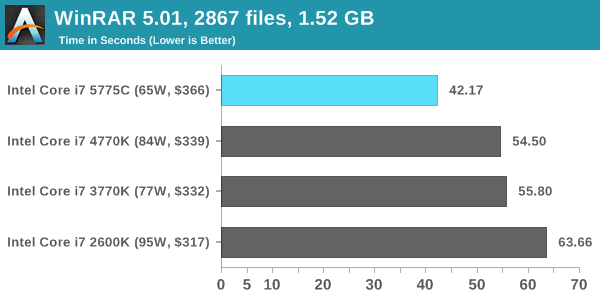
3D Particle Movement
3DPM is a self-penned benchmark, taking basic 3D movement algorithms used in Brownian Motion simulations and testing them for speed. High floating point performance, MHz and IPC wins in the single thread version, whereas the multithread version has to handle the threads and loves more cores.
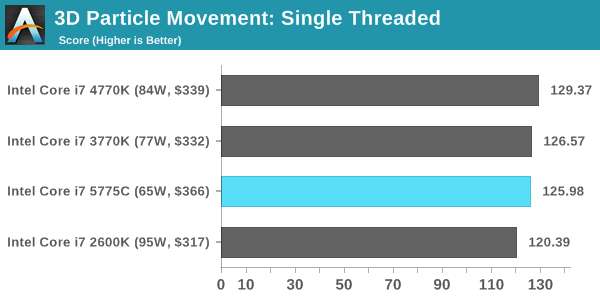
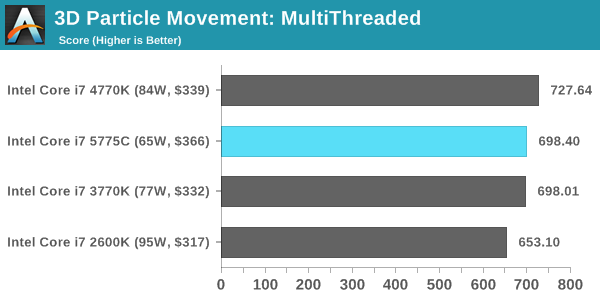
FastStone Image Viewer 4.9
FastStone is the program I use to perform quick or bulk actions on images, such as resizing, adjusting for color and cropping. In our test we take a series of 170 images in various sizes and formats and convert them all into 640x480 .gif files, maintaining the aspect ratio. FastStone does not use multithreading for this test, and results are given in seconds.
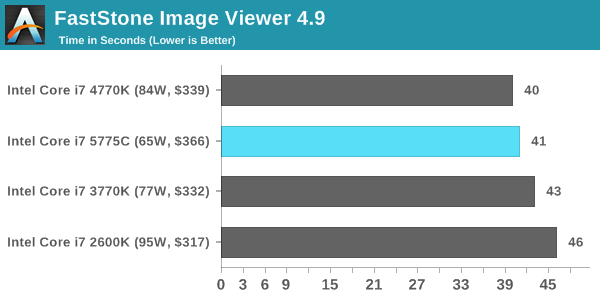
Web Benchmarks
On the lower end processors, general usability is a big factor of experience, especially as we move into the HTML5 era of web browsing. For our web benchmarks, we take four well known tests with Chrome 35 as a consistent browser.
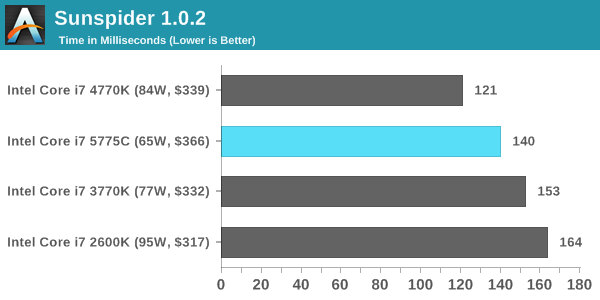
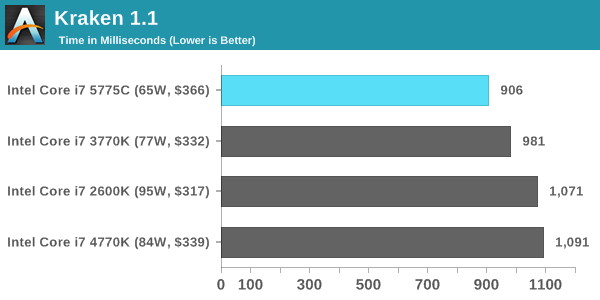
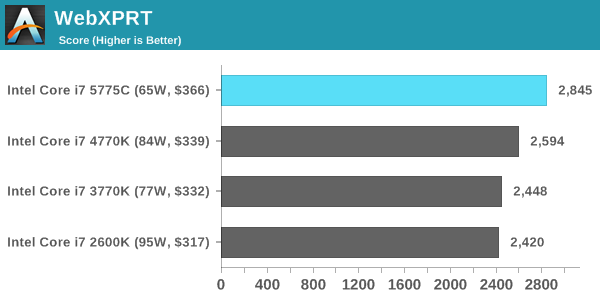
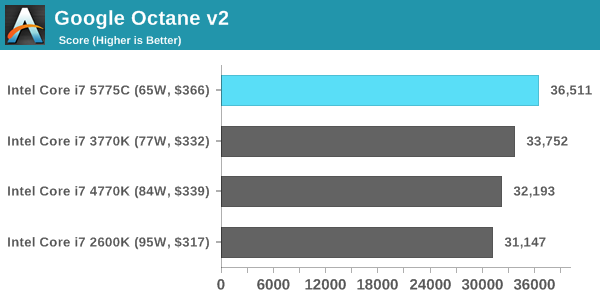










121 Comments
View All Comments
bernstein - Monday, August 3, 2015 - link
personally i'd be very interested what intel could do if it would push it's tdp to GPU levels (200-300W) and use that thermal headroom for added GPU EUs.possibly as a "dual die on one interposer" solution, to keep costs down
darckhart - Monday, August 3, 2015 - link
It looks like if you didn't upgrade before, may as well keep waiting. I'm on X58 with a X5650 and it looks like Skylake-E is the best bet for consideration.FlanK3r - Monday, August 3, 2015 - link
Nice review Ian :)TallestJon96 - Monday, August 3, 2015 - link
Not very compelling. All skylake needs to do is be indisputably the fastest, even if only by 10%, and it will seem like a huge upgrade.edlee - Monday, August 3, 2015 - link
yes, anyone with sandy bridge and ivy bridge i5 and i7 already knows not to upgrade cpu anymore.I don't replace SB or IVY, I only add systems for different locations.
The only thing I care about now is GPU improvements, and with DX12 we should see less cpu constraints.
MattVincent - Monday, August 3, 2015 - link
Nice Ian, Anyway we can get you to test the tdp down configuration? Intel states 37w can be achieved at 2.2ghz. As one that is looking this for an htpc processor upgrade the cpu performance is overkill for me, what Im interested in is the integrated graphics.Stuka87 - Monday, August 3, 2015 - link
Well, glad I went with a Devils Canyon haswell instead of waiting for Broadwell to launch this past spring.Welsh_Jester - Monday, August 3, 2015 - link
IPC is getting meaningless, I only upgraded to x99 a few months ago because I knew waiting wouldn't be worth it. And from what I've seen of Skylake and Broadwell, they're not worth the wait. Skylake wasn't even fairly benched in those leaked slides, so it had a 900mhz advantage over the 5820K. Clock both to 4ghz and I bet the Skylake chips are less than 10% faster overall.Imo 5820k is the best bet, 2 more cores where it matters and even DX12 may take advantage of them. Yes people are obviously going to go Broadwell or Skylake just for the IPC increase even if it is a very small increase, or people just want it literally for e-peen benchmarks where you wouldn't even see the difference in real life use.
Welsh_Jester - Monday, August 3, 2015 - link
Also to add to this, I upgraded from x58 and it was completely worth it, over 40% faster in IPC terms.. Plus the new tech of the mobo, SATA 3, much faster bootup and UEFI bios. The stuff coming in Skylake-e will have all the same and is still a ways off, only a small IPC increase difference.Dribble - Monday, August 3, 2015 - link
But so expensive, it's not just the cpu but a decent motherboard is easily twice the price of a non X99 one, and you really want quad channel DDR4 which also costs a lot.